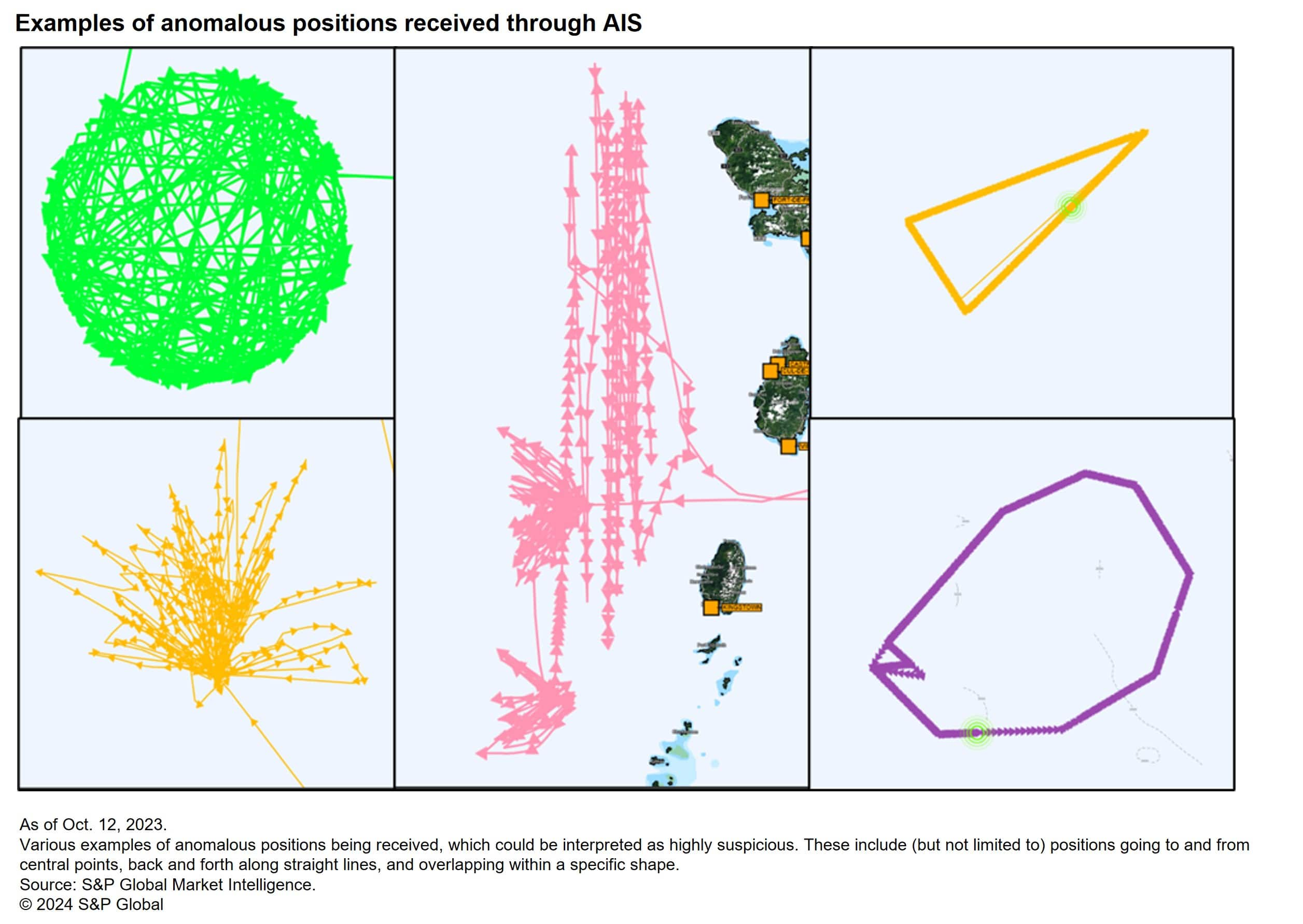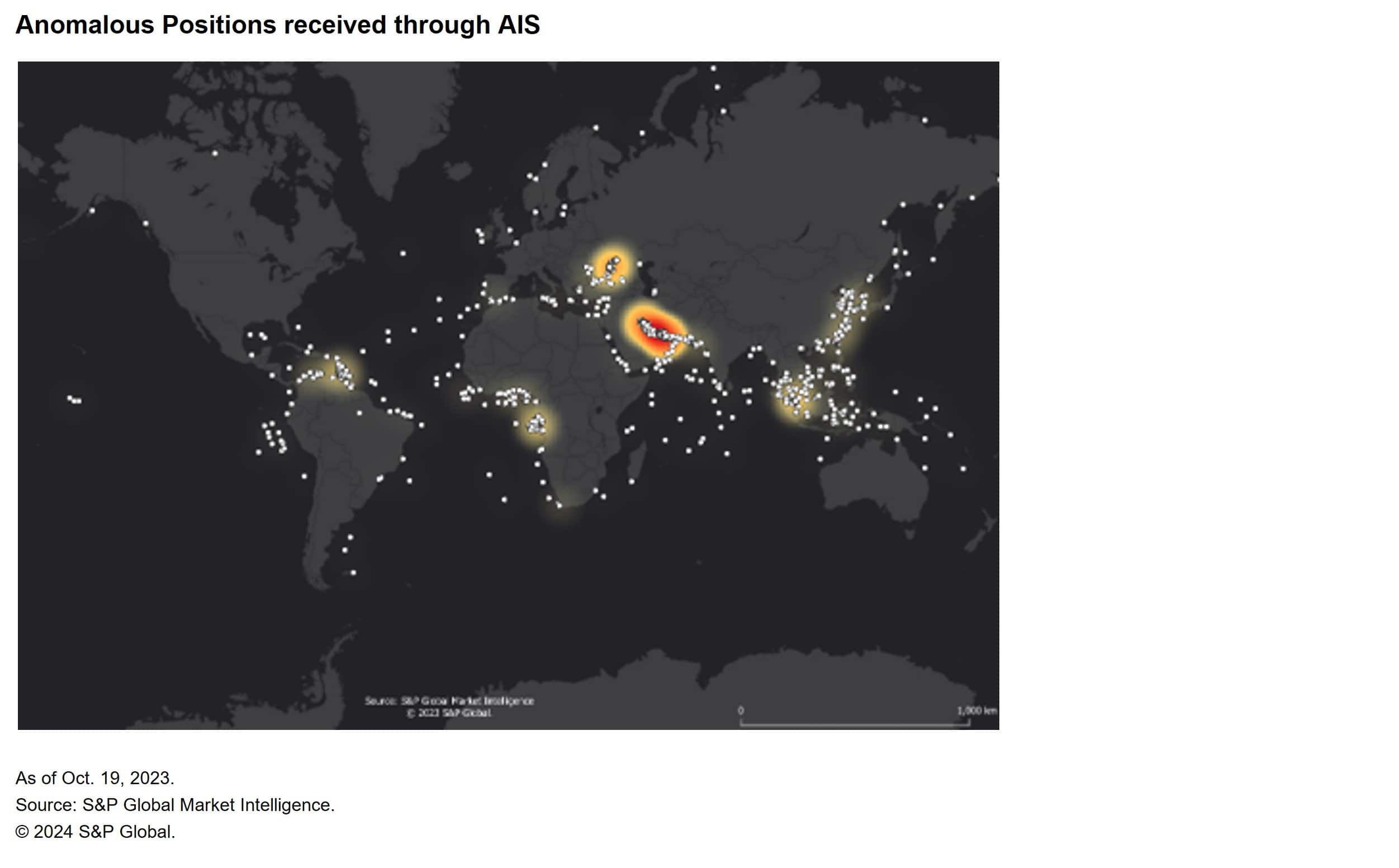S&P Global Offerings
Featured Topics
Featured Products
Events
S&P Global Offerings
Featured Topics
Featured Products
Events
S&P Global Offerings
Featured Topics
Featured Products
Events
Banking & Capital Markets
Economy & Finance
Energy Transition & Sustainability
Technology & Innovation
Podcasts & Newsletters
Banking & Capital Markets
Economy & Finance
Energy Transition & Sustainability
Technology & Innovation
Podcasts & Newsletters
S&P Global Offerings
Featured Topics
Featured Products
Events
WHITEPAPER — Feb 28, 2024
Voyage irregularities consist of misalignments or anomalous patterns of behaviors associated to the shipping of goods. This tactic has been on the rise and, unlike some of the other practices, can encapsulate multiple elements of tactics from automatic identification system (AIS) manipulation, to transshipment, discrepancies in loading/discharge locations, and more.
The advisory, in this instance, encourages further scrutiny in terms of vetting elements relating to the shipment of the goods, whereby tactics might have been used to disguise the ultimately destination or origin of cargo through different means.
The subject of "AIS manipulation" to carry out possible illicit activities has previously been covered in the Maritime State of Play Report: Evolution of deceptive shipping practices — Disabling/manipulating AIS(opens in a new tab); however, this practice has evolved to such a degree that elements of it can constitute as voyage irregularities.
With there being such a focus on "being seen," illicit actors quickly evolved their tactics with this in mind. Instead of going dark, or spoofing by falsifying their identity, the tactic of positional spoofing/manipulation became more common. This magician's tactic of "look here, while I do something over there" has been rather successful, with the goal to always continuously transmit through AIS as to not draw focus.
A ship can transmit all its correct digital identifiers and continually being "seen" while operating in a different area to where it physically is. This practice is now highly used as a tactic; however, it has its limitations. For those familiar with vessel movements, it can become obvious when a vessel operates in such a way that is not possible or out of line with economic norms; the tracks sometimes reveal intricate, impossible shapes, which might include hairpin turns, prolonged drifting, offsets, static positions or showing a multitude of different shapes.
These might often show in areas near where the vessel might physically be, whereas in others, these will show in proximity to where vessels might genuinely operate (such as in proximity to facilities/transshipment hubs).
Aside from the behaviors exhibited, one of the other challenges in this tactic is in being able to give the impression of carrying out legitimate operations all while carrying out illicit activities. Some of the earlier examples of this tactic being employed took place in early 2021, where several vessels crossed the Atlantic ballast to drift up and down next to the Caribbean islands for extended periods in linear motions, only to sail away fully laden despite not having engaged with any other vessels or called into any ports while in the area.
Many systems now capture these anomalies with built-in methodology to help reduce false positives, including Market Intelligence's MIRS.
Some key factors to review for these captures (note that this is not an exhaustive list) are as below:
There are other elements which cannot directly be investigated without access to meta elements, such as the receiver of the message or the coordinates of the position received in contrast to the location of the receiver.

With the notion of AIS manipulation being on the rise, new algorithms have been deployed by Market Intelligence to capture possible manipulation events. In this next section, we go over specific examples of tactics used, which consist of voyage irregularities that have been identified through these new algorithms.
The geospatial distribution of these events shows pockets of concentrations within specific areas of interest, which are currently under sanctions programs, or known as "areas of interest" for conducting these types of activity.

Click here(opens in a new tab) to download the full complimentary paper where we go over five examples of tactics used:
Example 1: Overlapping, offset positions
Example 2: Static, repeating positions
Example 3: Drifting with anomalous destination
Example 4: Out of receiver footprint
Example 5: False voyages
Subscribe to our complimentary Global Risk & Maritime quarterly newsletter(opens in a new tab) for the latest insight and opinion on trends shaping the shipping industry from trusted shipping experts.
This article was published by S&P Global Market Intelligence and not by S&P Global Ratings, which is a separately managed division of S&P Global.
How can our products help you?

